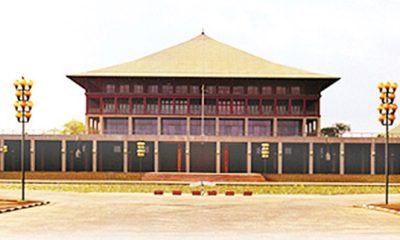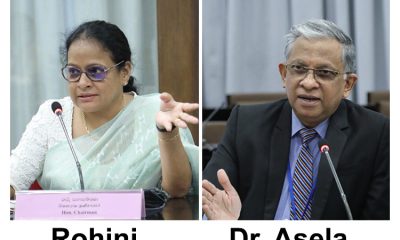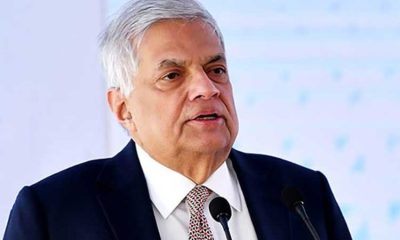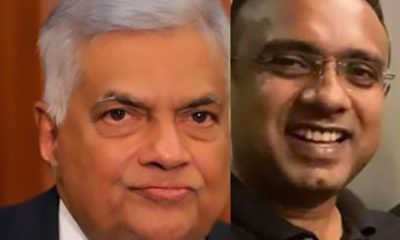Features
Special Neighbours of Convenience: Narendra Modi and Ranil Wickremesinghe

by Rajan Philips
Ranil Wickremesinghe is not only Sri Lanka’s parliamentary president; he is also a roving president. The President’s next capital of call is New Delhi. The Indian Foreign Secretary, Vinay Kwatra, was in Colombo this week reportedly to lay the groundwork for Mr. Wickremesinghe’s visit to Delhi on July 20 and 21. He came over to make sure that President Wickremesinghe’s visit to India next week will be “a point of positive transformation in the relationship” between the two countries. New Delhi might fancy that in President Wickremesinghe India has finally found a leader whose assurances that the government of India can trust. That may quite well be, but the question is if India can count on Wickremesinghe as a leader whose politics the people of Sri Lanka, especially the Sinhalese, will trust.
The politics of the visit can be seen from several angles – historical, contextual, more regional than geopolitical, and domestic political fallouts. From a domestic (electoral) standpoint, the visit will mean a great deal to President Wickremesinghe and nothing at all to the Modi government.
The point to make is that there is no Sri Lankan government in a political sense that will be implicated by the visit. There is only President Wickremesinghe. He stands alone as government, with opportunistic SLPP support in parliament. Indian accolades will be another moment of external validation for the Sri Lankan President, who will try to cash them electorally in Sri Lanka, but only with mixed results.
There is nothing to compare between Prime Minister Modi’s US visit in June and President Wickremesinghe’s visit to India in July. The only thing common might be the symbolism and ceremonies that were rolled out for Modi in Washington and those that will greet President Wickremesinghe in Delhi. The US is going all out to cultivate Modi as a reliable ally in international relations.
Modi’s objective on the other hand is to similarly cultivate the US as an international partner, but without losing India’s independence to retain its historical alliance with Russia and without diminishing its reliance on Russia as a source for arms and oil at very favourable prices. On China, India will go as farther as it can with the US including its active participation Quad, but will determine the contours of its engagement with China on its own terms.
Special Neighbours
All of this may seem consistent with the current Indian foreign policy of ‘all-alignment’ championed by Prime Minister Modi and Foreign Minister Jaishankar, which is a repudiation of the old Nehruvian policy of non-alignment and the adoption of a transactional approach to dealing with other countries strategically to further India’s permanent interests. Where does Sri Lanka fit in the new transactional framework of India’s foreign policy, and what is the positive point of transformation that India is hoping to see when President Wickremesinghe visits Delhi?
India’s foremost objective towards Sri Lanka would be to not only confirm but also showcase that India has a ‘special relationship’ with Sri Lanka which is superior to any relationship that Sri Lanka may have with any other country, especially China. Whether President Wickremesinghe’s visit next week will produce a moment of transformation when such a relationship can be articulated by both Prime Minister Modi and President Wickremesinghe remains to be seen. At most, the Sri Lankan President could go along with India as far as Sri Lanka could go while maintaining its ties with China at the same time. That would be an unexceptionable application of India’s transactional approach towards the US and towards China.
At the same time, there is no denying that among all South Asian countries Sri Lanka has emerged as a special neighbour of India. It may not be quite the application of the first principle of the Gujral Doctrine that “with neighbours like Nepal, Bangladesh, Bhutan, Maldives and Sri Lanka, India does not ask for reciprocity but gives all that it can in good faith and trust.” Reciprocity may not be asked for but it does follow in one form or another. Yet there is no question that when Sri Lanka was struck by its debilitating government-made forex crisis, India stepped up to give all it could and more in good faith and trust. It then made special pleadings with the IMF on Sri Lanka’s behalf.
As neighbours go, Bangladesh is not in any need for any help from anyone. Nepal, Bhutan and Maldives have problems and crises that are mostly manageable. Pakistan is a different case, and its needs are far severer than Sri Lanka’s. But Pakistan will never ask and India will never offer any assistance to Pakistan. Last Tuesday (July 11), Saudi Arabia deposited USD 2 billion in Pakistan’s Central Bank, ahead of a critical meeting of the IMF to approve a USD 3 billion loan to the country. Pakistan has been back and forth with IMF much longer than Sri Lanka has been in the current global debt crisis. It has all of Sri Lanka’s problem with everyone of them on a proportionately larger scale, and the additional aftermath of last year’s floods that has left over 1,700 people dead and USD 30 billion in damages. Yet there has been no offer from India to give anything it could in good faith and trust.
India’s main security fears are about spectacular terrorist attacks launched by militant groups based in Pakistan. China, on the other hand, is not seen as a threat but a strategic challenge. China is also India’s second largest trading partner (after the US), while trade among South Asian countries is nowhere near where it should be given their proximity, their massive collective market, and culturally compatible consumption habits. When Modi first came to power in 2014, his foreign focus was all on neighbours and the emphasis was on improving relationships with all of them, including Pakistan. Over time, the Modi government’s attitude to Pakistan hardened, and after his second election victory in 2019, relationship with Pakistan became an immediate casualty of the government’s increasing hostility towards Muslims in India.
President Wickremesinghe was quick to condemn the burning of Quran in Stockholm, Sweden, earlier this month by an Iraqi Christian immigrant, and asked what the UN Human Rights Council was doing about it. On July 12, the UNHRC passed a resolution calling on countries to “prevent and prosecute acts and advocacy of religious hatred that constitute incitement to discrimination, hostility or violence.” 28 countries, all Asian, African and Middle Eastern, voted for the resolution, 12 all Western countries plus Costa Rica voted against it on the grounds of concerns over violating free speech, and seven countries abstained. But no one questions the Modi government’s increasingly hostile treatment of Muslims and other religious minorities in India. Not to mention the harassment of opposition political leaders, including the politically motivated move to expel Rahul Gandhi from parliament based on his conviction in a rather bizarre defamation case involving Mr. Gandhi’s satirizing of the Modi name.
Hindutva Globalization
No one is expecting President Wickremesinghe to question the Indian government over human rights, minority rights violations, and the creeping authoritarianism at the federal level in India. No western country is questioning the Modi government on any of these matters, the way China is taken to task by them. Modi was once banned from visiting the US over the 2002 riots against Muslims in Gujarat when Modi was the State’s Chief Minister. Now he is among a handful of world leaders to have addressed a joint session of the US Congress more than once. All concerns over democracy and dissent were neatly tucked under the red carpet that was rolled out in Washington for the Indian Prime Minister.
While the Wickremesinghe visit to Delhi will have no domestic political benefits for the Modi government, the Modi visit to the US carried huge political benefits for the Modi government in India as Narendra Modi looks to extend his tenure as Prime Minister for a third term in the Lok Sabha elections next year. The Indian diaspora in the US is now one of the largest and increasingly influential immigrant groups in the country. The BJP and the Modi government have invested heavily in going global with their Hindutva politics targeting overseas Indians, primarily those in the US. The initial purpose behind this ‘globalization’ was to protect the BJP government and Prime Minister Modi from international sanctions.
The Hindutva globalization effort would seem to have served its initial purpose, and it is now spilling over into domestic politics not only in India but also in the US. Modi’s global appeal and adulations of him by Indians overseas will in turn be used to boost Modi’s national appeal in India to overarch the BJP’s many problems and setbacks at the state level in multiple states. On the other hand, in the US and other western countries Hindutva supporters are finding their natural harbours in conservative organizations. There have been indications that well to do Indian immigrants are gravitating to the Republican Party (similar to what happened with Catholic voters earlier), while Muslim Americans are moving in the opposite direction to the Democratic Party.
Ironically, South Asia is left out in the Hindutva globalization scheme of the BJP government. The omission is unfortunate even as it is inevitable given the Hindutva worldview and its outlook for the future of India. The special relationship with Sri Lanka is primarily intended as a counter to China in the South Asian region. Although a broader South Asian unity will benefit all South Asian countries including India, such a regional perspective cannot be fitted within the asecular Hindutva ideology.
There is another dynamic at play, a part of which is India’s interest in keeping alive the old Indo-Sri Lanka agreement and its main outcome, the 13th Amendment. Modi has been committed to it from his first day as Prime Minister, and in President Wickremesinghe he may have a reliable ally in Sri Lanka. The other part of the dynamic is BJP’s intent and effort to make an electoral breakthrough in Tamil Nadu in 2024, and the ongoing efforts to destabilize the current DMK hold over the State. The BJP-DMK bickering may not concern President Wickremesinghe but the fallout from it might spillover ever so lightly into Sri Lanka.
Features
The heart-friendly health minister

by Dr Gotabhya Ranasinghe
Senior Consultant Cardiologist
National Hospital Sri Lanka
When we sought a meeting with Hon Dr. Ramesh Pathirana, Minister of Health, he graciously cleared his busy schedule to accommodate us. Renowned for his attentive listening and deep understanding, Minister Pathirana is dedicated to advancing the health sector. His openness and transparency exemplify the qualities of an exemplary politician and minister.
Dr. Palitha Mahipala, the current Health Secretary, demonstrates both commendable enthusiasm and unwavering support. This combination of attributes makes him a highly compatible colleague for the esteemed Minister of Health.
Our discussion centered on a project that has been in the works for the past 30 years, one that no other minister had managed to advance.
Minister Pathirana, however, recognized the project’s significance and its potential to revolutionize care for heart patients.
The project involves the construction of a state-of-the-art facility at the premises of the National Hospital Colombo. The project’s location within the premises of the National Hospital underscores its importance and relevance to the healthcare infrastructure of the nation.
This facility will include a cardiology building and a tertiary care center, equipped with the latest technology to handle and treat all types of heart-related conditions and surgeries.
Securing funding was a major milestone for this initiative. Minister Pathirana successfully obtained approval for a $40 billion loan from the Asian Development Bank. With the funding in place, the foundation stone is scheduled to be laid in September this year, and construction will begin in January 2025.
This project guarantees a consistent and uninterrupted supply of stents and related medications for heart patients. As a result, patients will have timely access to essential medical supplies during their treatment and recovery. By securing these critical resources, the project aims to enhance patient outcomes, minimize treatment delays, and maintain the highest standards of cardiac care.
Upon its fruition, this monumental building will serve as a beacon of hope and healing, symbolizing the unwavering dedication to improving patient outcomes and fostering a healthier society.We anticipate a future marked by significant progress and positive outcomes in Sri Lanka’s cardiovascular treatment landscape within the foreseeable timeframe.
Features
A LOVING TRIBUTE TO JESUIT FR. ALOYSIUS PIERIS ON HIS 90th BIRTHDAY

by Fr. Emmanuel Fernando, OMI
Jesuit Fr. Aloysius Pieris (affectionately called Fr. Aloy) celebrated his 90th birthday on April 9, 2024 and I, as the editor of our Oblate Journal, THE MISSIONARY OBLATE had gone to press by that time. Immediately I decided to publish an article, appreciating the untiring selfless services he continues to offer for inter-Faith dialogue, the renewal of the Catholic Church, his concern for the poor and the suffering Sri Lankan masses and to me, the present writer.
It was in 1988, when I was appointed Director of the Oblate Scholastics at Ampitiya by the then Oblate Provincial Fr. Anselm Silva, that I came to know Fr. Aloy more closely. Knowing well his expertise in matters spiritual, theological, Indological and pastoral, and with the collaborative spirit of my companion-formators, our Oblate Scholastics were sent to Tulana, the Research and Encounter Centre, Kelaniya, of which he is the Founder-Director, for ‘exposure-programmes’ on matters spiritual, biblical, theological and pastoral. Some of these dimensions according to my view and that of my companion-formators, were not available at the National Seminary, Ampitiya.
Ever since that time, our Oblate formators/ accompaniers at the Oblate Scholasticate, Ampitiya , have continued to send our Oblate Scholastics to Tulana Centre for deepening their insights and convictions regarding matters needed to serve the people in today’s context. Fr. Aloy also had tried very enthusiastically with the Oblate team headed by Frs. Oswald Firth and Clement Waidyasekara to begin a Theologate, directed by the Religious Congregations in Sri Lanka, for the contextual formation/ accompaniment of their members. It should very well be a desired goal of the Leaders / Provincials of the Religious Congregations.
Besides being a formator/accompanier at the Oblate Scholasticate, I was entrusted also with the task of editing and publishing our Oblate journal, ‘The Missionary Oblate’. To maintain the quality of the journal I continue to depend on Fr. Aloy for his thought-provoking and stimulating articles on Biblical Spirituality, Biblical Theology and Ecclesiology. I am very grateful to him for his generous assistance. Of late, his writings on renewal of the Church, initiated by Pope St. John XX111 and continued by Pope Francis through the Synodal path, published in our Oblate journal, enable our readers to focus their attention also on the needed renewal in the Catholic Church in Sri Lanka. Fr. Aloy appreciated very much the Synodal path adopted by the Jesuit Pope Francis for the renewal of the Church, rooted very much on prayerful discernment. In my Religious and presbyteral life, Fr.Aloy continues to be my spiritual animator / guide and ongoing formator / acccompanier.
Fr. Aloysius Pieris, BA Hons (Lond), LPh (SHC, India), STL (PFT, Naples), PhD (SLU/VC), ThD (Tilburg), D.Ltt (KU), has been one of the eminent Asian theologians well recognized internationally and one who has lectured and held visiting chairs in many universities both in the West and in the East. Many members of Religious Congregations from Asian countries have benefited from his lectures and guidance in the East Asian Pastoral Institute (EAPI) in Manila, Philippines. He had been a Theologian consulted by the Federation of Asian Bishops’ Conferences for many years. During his professorship at the Gregorian University in Rome, he was called to be a member of a special group of advisers on other religions consulted by Pope Paul VI.
Fr. Aloy is the author of more than 30 books and well over 500 Research Papers. Some of his books and articles have been translated and published in several countries. Among those books, one can find the following: 1) The Genesis of an Asian Theology of Liberation (An Autobiographical Excursus on the Art of Theologising in Asia, 2) An Asian Theology of Liberation, 3) Providential Timeliness of Vatican 11 (a long-overdue halt to a scandalous millennium, 4) Give Vatican 11 a chance, 5) Leadership in the Church, 6) Relishing our faith in working for justice (Themes for study and discussion), 7) A Message meant mainly, not exclusively for Jesuits (Background information necessary for helping Francis renew the Church), 8) Lent in Lanka (Reflections and Resolutions, 9) Love meets wisdom (A Christian Experience of Buddhism, 10) Fire and Water 11) God’s Reign for God’s poor, 12) Our Unhiddden Agenda (How we Jesuits work, pray and form our men). He is also the Editor of two journals, Vagdevi, Journal of Religious Reflection and Dialogue, New Series.
Fr. Aloy has a BA in Pali and Sanskrit from the University of London and a Ph.D in Buddhist Philosophy from the University of Sri Lankan, Vidyodaya Campus. On Nov. 23, 2019, he was awarded the prestigious honorary Doctorate of Literature (D.Litt) by the Chancellor of the University of Kelaniya, the Most Venerable Welamitiyawe Dharmakirthi Sri Kusala Dhamma Thera.
Fr. Aloy continues to be a promoter of Gospel values and virtues. Justice as a constitutive dimension of love and social concern for the downtrodden masses are very much noted in his life and work. He had very much appreciated the commitment of the late Fr. Joseph (Joe) Fernando, the National Director of the Social and Economic Centre (SEDEC) for the poor.
In Sri Lanka, a few religious Congregations – the Good Shepherd Sisters, the Christian Brothers, the Marist Brothers and the Oblates – have invited him to animate their members especially during their Provincial Congresses, Chapters and International Conferences. The mainline Christian Churches also have sought his advice and followed his seminars. I, for one, regret very much, that the Sri Lankan authorities of the Catholic Church –today’s Hierarchy—- have not sought Fr.
Aloy’s expertise for the renewal of the Catholic Church in Sri Lanka and thus have not benefited from the immense store of wisdom and insight that he can offer to our local Church while the Sri Lankan bishops who governed the Catholic church in the immediate aftermath of the Second Vatican Council (Edmund Fernando OMI, Anthony de Saram, Leo Nanayakkara OSB, Frank Marcus Fernando, Paul Perera,) visited him and consulted him on many matters. Among the Tamil Bishops, Bishop Rayappu Joseph was keeping close contact with him and Bishop J. Deogupillai hosted him and his team visiting him after the horrible Black July massacre of Tamils.
Features
A fairy tale, success or debacle

Sri Lanka-Singapore Free Trade Agreement
By Gomi Senadhira
senadhiragomi@gmail.com
“You might tell fairy tales, but the progress of a country cannot be achieved through such narratives. A country cannot be developed by making false promises. The country moved backward because of the electoral promises made by political parties throughout time. We have witnessed that the ultimate result of this is the country becoming bankrupt. Unfortunately, many segments of the population have not come to realize this yet.” – President Ranil Wickremesinghe, 2024 Budget speech
Any Sri Lankan would agree with the above words of President Wickremesinghe on the false promises our politicians and officials make and the fairy tales they narrate which bankrupted this country. So, to understand this, let’s look at one such fairy tale with lots of false promises; Ranil Wickremesinghe’s greatest achievement in the area of international trade and investment promotion during the Yahapalana period, Sri Lanka-Singapore Free Trade Agreement (SLSFTA).
It is appropriate and timely to do it now as Finance Minister Wickremesinghe has just presented to parliament a bill on the National Policy on Economic Transformation which includes the establishment of an Office for International Trade and the Sri Lanka Institute of Economics and International Trade.
Was SLSFTA a “Cleverly negotiated Free Trade Agreement” as stated by the (former) Minister of Development Strategies and International Trade Malik Samarawickrama during the Parliamentary Debate on the SLSFTA in July 2018, or a colossal blunder covered up with lies, false promises, and fairy tales? After SLSFTA was signed there were a number of fairy tales published on this agreement by the Ministry of Development Strategies and International, Institute of Policy Studies, and others.
However, for this article, I would like to limit my comments to the speech by Minister Samarawickrama during the Parliamentary Debate, and the two most important areas in the agreement which were covered up with lies, fairy tales, and false promises, namely: revenue loss for Sri Lanka and Investment from Singapore. On the other important area, “Waste products dumping” I do not want to comment here as I have written extensively on the issue.
1. The revenue loss
During the Parliamentary Debate in July 2018, Minister Samarawickrama stated “…. let me reiterate that this FTA with Singapore has been very cleverly negotiated by us…. The liberalisation programme under this FTA has been carefully designed to have the least impact on domestic industry and revenue collection. We have included all revenue sensitive items in the negative list of items which will not be subject to removal of tariff. Therefore, 97.8% revenue from Customs duty is protected. Our tariff liberalisation will take place over a period of 12-15 years! In fact, the revenue earned through tariffs on goods imported from Singapore last year was Rs. 35 billion.
The revenue loss for over the next 15 years due to the FTA is only Rs. 733 million– which when annualised, on average, is just Rs. 51 million. That is just 0.14% per year! So anyone who claims the Singapore FTA causes revenue loss to the Government cannot do basic arithmetic! Mr. Speaker, in conclusion, I call on my fellow members of this House – don’t mislead the public with baseless criticism that is not grounded in facts. Don’t look at petty politics and use these issues for your own political survival.”
I was surprised to read the minister’s speech because an article published in January 2018 in “The Straits Times“, based on information released by the Singaporean Negotiators stated, “…. With the FTA, tariff savings for Singapore exports are estimated to hit $10 million annually“.
As the annual tariff savings (that is the revenue loss for Sri Lanka) calculated by the Singaporean Negotiators, Singaporean $ 10 million (Sri Lankan rupees 1,200 million in 2018) was way above the rupees’ 733 million revenue loss for 15 years estimated by the Sri Lankan negotiators, it was clear to any observer that one of the parties to the agreement had not done the basic arithmetic!
Six years later, according to a report published by “The Morning” newspaper, speaking at the Committee on Public Finance (COPF) on 7th May 2024, Mr Samarawickrama’s chief trade negotiator K.J. Weerasinghehad had admitted “…. that forecasted revenue loss for the Government of Sri Lanka through the Singapore FTA is Rs. 450 million in 2023 and Rs. 1.3 billion in 2024.”
If these numbers are correct, as tariff liberalisation under the SLSFTA has just started, we will pass Rs 2 billion very soon. Then, the question is how Sri Lanka’s trade negotiators made such a colossal blunder. Didn’t they do their basic arithmetic? If they didn’t know how to do basic arithmetic they should have at least done their basic readings. For example, the headline of the article published in The Straits Times in January 2018 was “Singapore, Sri Lanka sign FTA, annual savings of $10m expected”.
Anyway, as Sri Lanka’s chief negotiator reiterated at the COPF meeting that “…. since 99% of the tariffs in Singapore have zero rates of duty, Sri Lanka has agreed on 80% tariff liberalisation over a period of 15 years while expecting Singapore investments to address the imbalance in trade,” let’s turn towards investment.
Investment from Singapore
In July 2018, speaking during the Parliamentary Debate on the FTA this is what Minister Malik Samarawickrama stated on investment from Singapore, “Already, thanks to this FTA, in just the past two-and-a-half months since the agreement came into effect we have received a proposal from Singapore for investment amounting to $ 14.8 billion in an oil refinery for export of petroleum products. In addition, we have proposals for a steel manufacturing plant for exports ($ 1 billion investment), flour milling plant ($ 50 million), sugar refinery ($ 200 million). This adds up to more than $ 16.05 billion in the pipeline on these projects alone.
And all of these projects will create thousands of more jobs for our people. In principle approval has already been granted by the BOI and the investors are awaiting the release of land the environmental approvals to commence the project.
I request the Opposition and those with vested interests to change their narrow-minded thinking and join us to develop our country. We must always look at what is best for the whole community, not just the few who may oppose. We owe it to our people to courageously take decisions that will change their lives for the better.”
According to the media report I quoted earlier, speaking at the Committee on Public Finance (COPF) Chief Negotiator Weerasinghe has admitted that Sri Lanka was not happy with overall Singapore investments that have come in the past few years in return for the trade liberalisation under the Singapore-Sri Lanka Free Trade Agreement. He has added that between 2021 and 2023 the total investment from Singapore had been around $162 million!
What happened to those projects worth $16 billion negotiated, thanks to the SLSFTA, in just the two-and-a-half months after the agreement came into effect and approved by the BOI? I do not know about the steel manufacturing plant for exports ($ 1 billion investment), flour milling plant ($ 50 million) and sugar refinery ($ 200 million).
However, story of the multibillion-dollar investment in the Petroleum Refinery unfolded in a manner that would qualify it as the best fairy tale with false promises presented by our politicians and the officials, prior to 2019 elections.
Though many Sri Lankans got to know, through the media which repeatedly highlighted a plethora of issues surrounding the project and the questionable credentials of the Singaporean investor, the construction work on the Mirrijiwela Oil Refinery along with the cement factory began on the24th of March 2019 with a bang and Minister Ranil Wickremesinghe and his ministers along with the foreign and local dignitaries laid the foundation stones.
That was few months before the 2019 Presidential elections. Inaugurating the construction work Prime Minister Ranil Wickremesinghe said the projects will create thousands of job opportunities in the area and surrounding districts.
The oil refinery, which was to be built over 200 acres of land, with the capacity to refine 200,000 barrels of crude oil per day, was to generate US$7 billion of exports and create 1,500 direct and 3,000 indirect jobs. The construction of the refinery was to be completed in 44 months. Four years later, in August 2023 the Cabinet of Ministers approved the proposal presented by President Ranil Wickremesinghe to cancel the agreement with the investors of the refinery as the project has not been implemented! Can they explain to the country how much money was wasted to produce that fairy tale?
It is obvious that the President, ministers, and officials had made huge blunders and had deliberately misled the public and the parliament on the revenue loss and potential investment from SLSFTA with fairy tales and false promises.
As the president himself said, a country cannot be developed by making false promises or with fairy tales and these false promises and fairy tales had bankrupted the country. “Unfortunately, many segments of the population have not come to realize this yet”.
(The writer, a specialist and an activist on trade and development issues . )
























